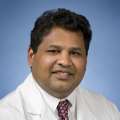Seattle Biopsy Protocol Versus Wide-Area Transepithelial Sampling in Patients With Barrett's Esophagus Undergoing Surveillance
About
The purpose of this research study is to learn about the best approach to sample patients with known or suspected Barrett's esophagus (BE) by comparing the standard Seattle biopsy protocol to sampling using wide area transepithelial sampling (WATS3D).
Barrett's esophagus is a common condition that is used to spot patients at increased risk of developing a type of cancer in the esophagus (swallowing tube) called esophageal adenocarcinoma. The 5-year survival rate is as low as 18% for patients who get esophageal adenocarcinoma, but the rate may be improved if the cancer is caught in its early stages. Barrett's esophagus can lead to dysplasia, or precancerous changes, which occurs when cells look abnormal but have not developed into cancer. If the abnormal cells increase from being slightly abnormal (low-grade dysplasia), to being very abnormal (high-grade dysplasia), the risk of developing cancer (esophageal adenocarcinoma) goes up. Therefore, catching dysplasia early is very important to prevent cancer.
Endoscopic surveillance is a type of procedure where endoscopists run a tube with a light and a camera on the end of it down a patients throat and remove a small piece of tissue. The piece of tissue, called a biopsy, is about the size of the tip of a ball-point pen and is checked for abnormal cells and cancer cells.
Patients are being asked to be in this research study because they have been diagnosed with BE or suspected to have BE, and will need an esophagogastroduodenoscopy (EGD).
Patients with BE undergo sampling using the Seattle biopsy protocol during which samples are obtained from the BE in a four quadrant fashion every 2 cm along with target biopsies from any abnormal areas within the BE. Another sampling approach is WATS3D which utilizes brushings from the BE.
While both of these procedures are widely accepted approaches to sampling patients with BE during endoscopy, there is not enough research to show if one is better than the other.
Participants in this study will undergo sampling of the BE using both approaches (Seattle biopsy protocol and WATS-3D); the order of the techniques will be randomized.
Up to 2700 participants will take part in this research. This is a multicenter study involving several academic, community and private hospitals around the country.
Eligibility
Inclusion Criteria:
Surveillance Population
- Undergoing surveillance endoscopy for a diagnosis of non-dysplastic Barrett's esophagus (NDBE, based on last endoscopic procedure; patients with prior history of low-grade dysplasia/indefinite for dysplasia with NDBE at last endoscopy can be included)
- Barrett's esophagus (BE) length of at least M1
- English and Spanish speaking
- Able to comprehend and complete the consent form
- Age18-89 years
- Life-expectancy of at least 2 years Screening Population
- Undergoing endoscopy for screening of BE
- BE length of at least M1
- English and Spanish speaking
- Able to comprehend and complete the consent form
- Age 18-89 years
- Expected life-expectancy of at least 2 years Physicians -All participating sites will include physicians who are trained in the use of WATS3D and certified by the site PI. All endoscopists will need to complete a minimum of three cases to be eligible to participate in the study.
Exclusion Criteria:
Surveillance Population
- BE patients undergoing surveillance or evaluation for endoscopic eradication therapy (EET) for prior diagnosis of BE related dysplasia or esophageal adenocarcinoma (EAC)
- Active erosive esophagitis with LA Grade B or higher
- Esophageal varices
- Prior history of EET
- Prior history of esophageal or gastric surgery, except for uncomplicated fundoplication
- Pregnancy Screening Population
- BE patients undergoing surveillance or evaluation for EET for prior diagnosis for BE-related dysplasia or EAC
- Active erosive esophagitis with LA Grade B or higher
- Esophageal varices
- Prior history of esophageal or gastric surgery, except for uncomplicated fundoplication
- Pregnancy
Join this Trial
- UCLA Westwood
